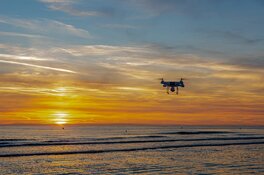Red Cat Holdings Inc. (RCAT:NASDAQ) and Palladyne AI Corp. (NASDAQ: PDYN and PDYNW) announced the successful completion of a cross-platform collaborative drone flight, marking a key step in their ongoing collaboration to advance autonomous drone operations. The test involved three heterogeneous drones, Red Cat’s Teal 2 and Black Widow models, operating with Palladyne AI’s Pilot software, which enables distributed autonomy using onboard edge computing and limited communication protocols.
The milestone expands on prior tests by the two companies, which included a single-drone autonomous flight in December 2024 and a two-drone flight in January 2025. According to the announcement, the recent trial demonstrated real-time detection and tracking of multiple dynamic and static ground objects, including humans and vehicles, across different regions. All drones communicated autonomously without relying on a centralized infrastructure, providing a single operator with enhanced situational awareness.
“This new testing milestone represents significant progress in our joint mission with Red Cat to enable multi-drone interoperability and autonomous collaboration for the defense sector,” said Matt Vogt, Chief Revenue Officer of Palladyne AI in the announcement. He added, “We are proud to have successfully completed this three-drone flight and believe our joint, cross-platform, autonomous solution will be a game changer for U.S. military personnel and drone operators.”
Geoff Hitchcock, Chief Revenue Officer of Red Cat, noted that the achievement underscored the maturity of both the hardware and AI software. “Successfully expanding from single to three-drone operations reflects not only the reliability of our drones and Palladyne’s AI software, but also the capability of onboard systems to independently handle complex missions,” Hitchcock said.
The Palladyne Pilot AI software, designed to transform unmanned tactical systems into autonomous platforms capable of collaborative sensing and persistent target tracking, was developed under multiple contracts with the U.S. Air Force. According to company materials, the software is commercially available and intended for military, defense, and civil use cases.
Red Cat, through its subsidiaries Teal Drones and FlightWave Aerospace, has developed a Family of Systems, including the Black Widow, which was awarded the U.S. Army’s Short Range Reconnaissance (SRR) Program of Record contract. The company also manufactures other drones, such as the TRICHON and the FANG, each designed to meet U.S. Department of Defense compliance requirements.
Commercial Drone Sector Sees Expansion and Rising Adoption
The global commercial drone services market continued its strong growth trajectory in early 2025, driven by accelerated adoption across critical sectors such as energy, infrastructure, and logistics. According to Fact.MR, the industry was valued at US$7.62 billion in 2025 and was projected to grow at a compound annual growth rate of 14.8% through 2035, reaching US$30.3 billion by the end of the forecast period. The analysis noted that the commercial drone industry shifted from pilot projects to full-scale deployments across multiple regions, with energy utilities and agriculture spearheading widespread use cases. Fact.MR explained that utilities applied drones to monitor transmission lines and vegetation management, resulting in aerial survey cost reductions of up to 60%. In agriculture, drones equipped with multispectral imaging and machine learning-based analytics were used to enhance yield efficiency through site-specific spraying.
In its report, Fact.MR stated that early 2025 marked a significant consolidation period for enterprise-level drone models, particularly in energy, security, and logistics applications. It highlighted that new infrastructure focused on fleet management and airspace coordination was developing in parallel with these operational deployments. One of the key enabling factors for this growth was regulatory progress. Fact.MR reported that approvals for BVLOS (Beyond Visual Line of Sight) operations in select regions allowed drones to conduct longer-range missions, which expanded their practical utility for companies managing large-scale operations.
A global survey conducted by Fact.MR in late 2024, involving 500 stakeholders across the USA, Western Europe, Japan, and South Korea, found that 82% of respondents prioritized regulatory compliance when making purchasing decisions. The report noted that in the United States, 68% of stakeholders identified autonomous navigation and AI-driven analytics systems as essential for addressing labor shortages, underscoring the sector’s emphasis on automation. The same survey revealed that stakeholders in Western Europe placed strong importance on sustainability and environmental factors, with 89% citing the need for recyclable materials and a lower carbon footprint as primary considerations.
In addition to enterprise adoption, Fact.MR’s outlook pointed to increasing investments in automation, edge computing, and AI-enhanced sensory technologies, which were expected to deepen drone integration into industrial workflows. It observed that drones were evolving from experimental tools into operational assets embedded within digital transformation initiatives across sectors such as energy, public safety, and logistics. The report also identified inspection services as one of the fastest-growing categories within commercial drone services, citing a projected growth rate of 15.6% through 2035, driven by heightened demand in safety-critical industries.
Meanwhile, Business Insider reported in early May that Ukraine’s Defense Intelligence service had successfully used naval drones equipped with missile systems to down two Russian Su-30 fighter jets, a development it described as a historic first. According to the report, Ukraine employed Magura naval drones, which launched AIM-9 Sidewinder missiles to destroy the jets near the Novorossiysk port. Lt. Gen. Kyrylo Budanov, speaking to The War Zone, confirmed that the operation demonstrated the evolving capabilities of autonomous and semi-autonomous drone platforms in active military engagements. Business Insider highlighted that Ukraine’s growing naval drone fleet had been central to its strategy in countering Russian assets in the Black Sea, further emphasizing how drones were reshaping both maritime and aerial combat dynamics.
Analyst Coverage Underscores Strong Institutional Confidence
On March 11, Northland Capital Markets initiated coverage of Red Cat Holdings with an “Outperform” rating, reflecting a favorable view of the company’s growth prospects in the defense-oriented drone market. The firm provided a one-year price target average of US$15.30 per share, with estimates ranging between US$15.15 and US$15.75. This average price target implied a 210.03% increase from Red Cat’s most recent closing price of US$4.94 per share at the time of the report.
Fintel also reported that Red Cat’s projected annual revenue was US$75 million, representing a year-over-year increase of 356.30%. The company's projected annual non-GAAP earnings per share (EPS) stood at US$0.03. As of early March, institutional interest had expanded significantly, with 124 institutions or funds reporting positions in Red Cat. This represented a 65.33% increase from the prior quarter, while total institutional share ownership grew by 105.05% to 29.3 million shares.
Portfolio allocations among institutional investors also saw notable gains. Waddell & Associates disclosed a new position totaling approximately 12.4 million shares, equating to 15.50% ownership of the company. Susquehanna International Group increased its holdings by 69.56% to more than 2.1 million shares and raised its portfolio allocation to Red Cat by 1,335.85%.
Fintel concluded that Red Cat’s put/call ratio of 0.35 indicated a bullish stance among options traders. Collectively, the data suggested strong institutional conviction in Red Cat Holdings’ strategic role within the expanding defense and drone technology sector.
A May 5 report from technical analyst Clive Maund on Red Cat Holdings described the company as entering a new technical phase after completing a Double Bottom pattern, following a breakdown earlier in the year from a Head-and-Shoulders top. The analysis noted that Red Cat’s stock had declined to approximately US$4.50 before stabilizing and forming the current base. “By the look of it, Friday’s sharp gain on good volume marks the start of the completion of the Double Bottom,” the report stated, pointing to strengthening technical indicators including a rising 200-day moving average, positive divergence in the Accumulation line, and an upward trend in momentum (MACD) from a March low.
The report also highlighted the May 1 announcement of the collaborative drone flight between Red Cat and Palladyne AI as a fundamental catalyst supporting the stock’s current trajectory. The author wrote that Red Cat had become “an established player in the space and a ‘go to’ company” amid growing global demand for military-grade drones. While the US$7.00 to US$9.00 range was cited as a potential area of resistance, the report concluded that the current technical setup and news flow suggested the onset of a new growth phase.
Advancing Aerial Autonomy: Strategic Position and Opportunities
Red Cat Holdings’ investor presentation highlights its strategic role in meeting rising defense and homeland security demand for secure and autonomous drone technology. The company’s Teal 2 drone has been approved as a Blue sUAS (Small Unmanned Aerial System) by the U.S. Department of Defense, a designation that confirms compliance with rigorous cybersecurity and supply chain standards. Red Cat is one of only two manufacturers producing mass-market Blue UAS systems, positioning it advantageously for U.S. government procurement.
The company’s participation in the U.S. Army’s SRR Program of Record is a key milestone. SRR Tranche 1 involved a US$100 million production contract for 1,083 drones, with future tranches expected to deploy approximately 12,000 drones. Red Cat reported booked sales of US$13.04 million in fiscal year 2024, with US$5.6 million shipped through the second quarter and a backlog of US$7.4 million.
Beyond defense, Red Cat’s agreement with the Department of Homeland Security provides additional growth avenues. The company secured a US$2 million contract under a five-year ordering period valued at up to US$90 million, supplying drones for reconnaissance and surveillance to Customs and Border Protection.
Red Cat has also been advancing its manufacturing capabilities. Its Salt Lake City facility, completed in 2023, produces 100% of the company’s value-added drone components domestically or through allied nations. The company’s stated goal is to reach a monthly production rate of over 1,000 systems, with yield targets of 98%.
Ongoing partnerships with Tomahawk Robotics, Reveal Technology, Athena AI, Teledyne FLIR, and other tech firms further enhance Red Cat’s product offerings by integrating advanced AI, imaging, and networking solutions. The investor presentation cites an expanding international footprint, noting that 15 Teal drones have been deployed to a NATO country for operations in Ukraine.
With U.S. government procurement and international defense contracts growing in priority, Red Cat continues to position itself at the forefront of aerial intelligence and autonomous systems innovation.
Ownership and Share Structure
According to Refinitiv, management and insiders own just under 19% of Red Cat, including CEO Thompson, who holds 14.46%.
Institutional investors own about 33.69%. The Vanguard Group Inc. has 2.93%, AWM Investment Co. owns 2.10%, and Pelion Venture Partners has 1.05%.
The rest is in retail.
The drone company has 85.62M outstanding shares and 69.19M free float traded shares. Its market cap is US$497.87M. Over the past 52 weeks, its stock has traded between US$0.75 and US$15.27 per share.
| Want to be the first to know about interesting Technology investment ideas? Sign up to receive the FREE Streetwise Reports' newsletter. | Subscribe |
Important Disclosures:
- As of the date of this article, officers and/or employees of Streetwise Reports LLC (including members of their household) own securities of Red Cat Holdings
- James Guttman wrote this article for Streetwise Reports LLC and provides services to Streetwise Reports as an employee.
- This article does not constitute investment advice and is not a solicitation for any investment. Streetwise Reports does not render general or specific investment advice and the information on Streetwise Reports should not be considered a recommendation to buy or sell any security. Each reader is encouraged to consult with his or her personal financial adviser and perform their own comprehensive investment research. By opening this page, each reader accepts and agrees to Streetwise Reports' terms of use and full legal disclaimer. Streetwise Reports does not endorse or recommend the business, products, services or securities of any company.
For additional disclosures, please click here.








































